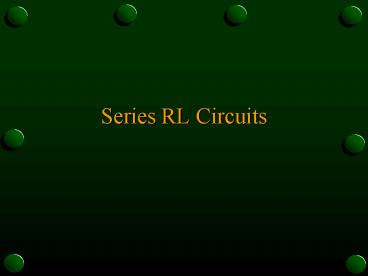Series RL Circuits - PowerPoint PPT Presentation
1 / 20
Title:
Series RL Circuits
Description:
Z and PA are both the hypotenuse of the triangle. ... be found by the cosine of the angle formed by the adjacent side and hypotenuse. Therefore: ... – PowerPoint PPT presentation
Number of Views:150
Avg rating:3.0/5.0
Title: Series RL Circuits
1
Series RL Circuits
2
Objectives
- Compare and contrast series RL circuits with
series RC circuits - Analyze and determine voltages, current,
impedance, and phase angle in any series RL
circuits given the necessary parameters. - Define true power, reactive power, and apparent
power as they pertain to reactive circuits. - Determine the three powers mentioned above given
circuit parameters. - Determine the power factor of a given reactive
circuit. - Discuss inductor quality and its impact on series
RL circuits. - Determine the quality factor of an inductor.
- Determine the quality factor of a circuit
containing an inductor.
3
Series RC Circuit
4
Series RL Circuit
5
Series RC vs RL Comparison
- RC
- ? will be between 0 and -90
- RL
- ? will be between 0 and 90
6
Series RC vs RL Comparison
- RC
- RL
7
Series RL Analysis
- Determine impedance and phase angle.
- R 56 ?
- XL 100 ?
- Z
- ?
8
Series RL Analysis
- Determine circuit Z, ?, and VS
- R 10 K?
- L 100 mH
- f 10 KHz
- Z
- ?
- VS
IT 200 µA
9
Series RL Analysis
- Determine source voltage and phase angle.
- VR 50 volts
- VL 35 volts
- VS
- ?
10
Power Consumption
Resistive Power (PR) or True Power (PT)
11
Power Consumption
Reactive Power (PX) or imaginary power
12
Apparent Power (PA) is the vector sum of true
power and reactive power
13
Power Factor (PF)
- Ratio of true power to apparent power.
- Measure of the power loss in a circuit.
14
Power Factor (PF)
- True power is a function of the pure resistance
(R) of the circuit. - Apparent power is a function of the total
impedance (Z) of the circuit. - Therefore, the power factor is also a ratio of
the circuit resistance to the circuit impedance.
15
Power Factor (PF)
- Compare the impedance triangle to the power
triangle. - R and PR are both the side adjacent to angle ?.
- Z and PA are both the hypotenuse of the triangle.
- The phase angle of a series reactive circuit can
be found by the cosine of the angle formed by the
adjacent side and hypotenuse. Therefore
16
Inductor Quality Factor (Q)
- An inductor has resistance due to the fact that
it is simply a piece of wire. All wire has
resistance. - This resistance (RW) results in some true power
being consumed by the inductor. - Even in a purely inductive circuit, RW is
present and subtracts for the total energy that
can be stored in the field.
17
Inductor Quality Factor (Q)
- This resistance appears to be in series with the
inductor. - Generally speaking, it is very small and can be
ignored, but in some applications it must be
considered.
18
Quality Factor (Q)
- The quality factor (Q) of a coil is a ratio of
the energy stored in the field (due to XL) to the
energy dissipated in the coil by the resistance
(due to RW). - Q is a figure of merit and has no unit of
measurement.
19
- A given series RC circuit has the following
- R 2.2 K?
- XC 3.3 K ?
- VS 5 V
- Find
- Z
- I
- ?
- PR
- PX
- PA
- PF
20
- A given series RL circuit has the following
- R 39.5 K?
- RW 500 ?
- L 450 mH
- VS 6 V
- f 20 KHz
- Find
- XL
- Z
- I
- ?
- PR
- PX
- PA
- PF
- Inductor Q
- Circuit Q































